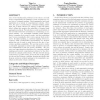19 search results - page 2 / 4 » Application of prioritized aggregation operators in preferen... |
COLING
2002
13 years 5 months ago
2002
To better understand the ordering of clause aggregation operators in a text generation application, we manually annotated a small corpus. The annotated corpus supports the preferr...
HICSS
2005
IEEE
13 years 11 months ago
2005
IEEE
It is well-known that linguistic decision-making problems that manage preferences from different experts follow a common resolution scheme composed by two phases: an aggregation p...
ER
2011
Springer
12 years 5 months ago
2011
Springer
Abstract. User preferences are a fundamental ingredient of personalized database applications, in particular those in which the user context plays a key role. Given a set of prefer...
SIGECOM
2010
ACM
13 years 10 months ago
2010
ACM
One of the fundamental problems in the theory of social choice is aggregating the rankings of a set of agents (or voters) into a consensus ranking. Rank aggregation has found appl...
AAAI
2006
13 years 7 months ago
2006
Voting (or rank aggregation) is a general method for aggregating the preferences of multiple agents. One important voting rule is the Slater rule. It selects a ranking of the alte...

